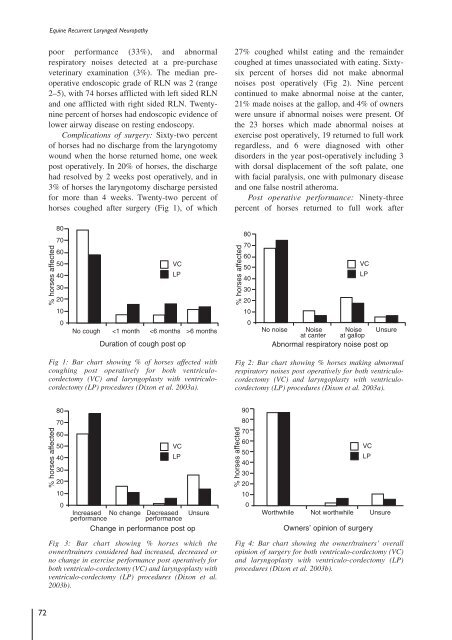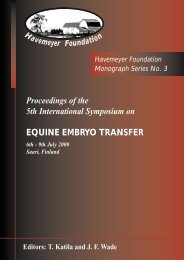Proceedings of a Workshop on - The Havemeyer Foundation
Proceedings of a Workshop on - The Havemeyer Foundation
Proceedings of a Workshop on - The Havemeyer Foundation
Create successful ePaper yourself
Turn your PDF publications into a flip-book with our unique Google optimized e-Paper software.
Equine Recurrent Laryngeal Neuropathy<br />
poor performance (33%), and abnormal<br />
respiratory noises detected at a pre-purchase<br />
veterinary examinati<strong>on</strong> (3%). <strong>The</strong> median preoperative<br />
endoscopic grade <str<strong>on</strong>g>of</str<strong>on</strong>g> RLN was 2 (range<br />
2–5), with 74 horses afflicted with left sided RLN<br />
and <strong>on</strong>e afflicted with right sided RLN. Twentynine<br />
percent <str<strong>on</strong>g>of</str<strong>on</strong>g> horses had endoscopic evidence <str<strong>on</strong>g>of</str<strong>on</strong>g><br />
lower airway disease <strong>on</strong> resting endoscopy.<br />
Complicati<strong>on</strong>s <str<strong>on</strong>g>of</str<strong>on</strong>g> surgery: Sixty-two percent<br />
<str<strong>on</strong>g>of</str<strong>on</strong>g> horses had no discharge from the laryngotomy<br />
wound when the horse returned home, <strong>on</strong>e week<br />
post operatively. In 20% <str<strong>on</strong>g>of</str<strong>on</strong>g> horses, the discharge<br />
had resolved by 2 weeks post operatively, and in<br />
3% <str<strong>on</strong>g>of</str<strong>on</strong>g> horses the laryngotomy discharge persisted<br />
for more than 4 weeks. Twenty-two percent <str<strong>on</strong>g>of</str<strong>on</strong>g><br />
horses coughed after surgery (Fig 1), <str<strong>on</strong>g>of</str<strong>on</strong>g> which<br />
27% coughed whilst eating and the remainder<br />
coughed at times unassociated with eating. Sixtysix<br />
percent <str<strong>on</strong>g>of</str<strong>on</strong>g> horses did not make abnormal<br />
noises post operatively (Fig 2). Nine percent<br />
c<strong>on</strong>tinued to make abnormal noise at the canter,<br />
21% made noises at the gallop, and 4% <str<strong>on</strong>g>of</str<strong>on</strong>g> owners<br />
were unsure if abnormal noises were present. Of<br />
the 23 horses which made abnormal noises at<br />
exercise post operatively, 19 returned to full work<br />
regardless, and 6 were diagnosed with other<br />
disorders in the year post-operatively including 3<br />
with dorsal displacement <str<strong>on</strong>g>of</str<strong>on</strong>g> the s<str<strong>on</strong>g>of</str<strong>on</strong>g>t palate, <strong>on</strong>e<br />
with facial paralysis, <strong>on</strong>e with pulm<strong>on</strong>ary disease<br />
and <strong>on</strong>e false nostril atheroma.<br />
Post operative performance: Ninety-three<br />
percent <str<strong>on</strong>g>of</str<strong>on</strong>g> horses returned to full work after<br />
% horses affected<br />
80<br />
70<br />
60<br />
50<br />
40<br />
30<br />
20<br />
10<br />
VC<br />
LP<br />
% horses affected<br />
80<br />
70<br />
60<br />
50<br />
40<br />
30<br />
20<br />
10<br />
VC<br />
LP<br />
0<br />
No cough








